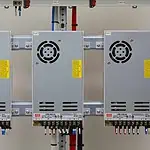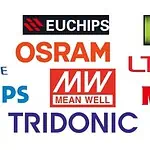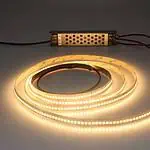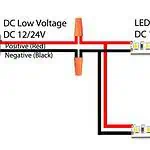As energy laws have gotten stricter, most people know that LEDs, or light-emitting diodes, last a long time and save energy. But few people understand that these high-tech light sources can’t work without an LED driver. LED drivers, sometimes called LED power supplies, are like ballasts for fluorescent lights or transformers for low-voltage bulbs. They give LEDs the electricity they need to run and work at their best.
What Is An LED Driver?
An LED driver controls how much power an LED or a group of LEDs needs. Since light-emitting diodes are low-energy lighting devices with long life and low energy use, they need specialized power sources.
The main jobs of LED drivers are to provide low voltage and protect LEDs.
Each LED can use up to 30mA of current and work at voltages of about 1.5V to 3.5V. Multiple LEDs can be used in series and parallel to make home lighting, which may need a total voltage of 12 to 24 V DC. The LED driver turns the AC around to meet the needs and lowers the voltage. This means that the high AC mains voltage, which ranges from 120V to 230V, must be changed into the low DC voltage that is needed.
The LED drivers also protect the LEDs from changes in voltage and current. Even if the mains supply changes, the circuits ensure that the voltage and current going to the LEDs stay in the suitable range for them to work. The protection stops the LEDs from getting too much voltage and current, which would hurt them, or insufficient current, making them less bright.
How Do LED Drivers Work?
When the temperature of an LED changes, so do its forward voltage needs. As it gets hotter, less voltage is needed to move current through the LED, so it uses more power. Thermal runaway is when the temperature goes up out of control and burns out an LED. The power output levels on LED drivers are made to meet the needs of LEDs. The driver’s constant current keeps the temperature stable by responding to changes in the forward voltage.
What Is An LED Driver Used For?
Transformers for low-voltage light bulbs do the same thing that LED drivers do for LEDs. LED lights are low-voltage devices that usually run on 4V, 12V, or 24V. To work, they need a source of direct current power. But because wall socket power supplies typically have a much higher Voltage (between 120V and 277V) and produce alternating current, they are not directly compatible. Since the average voltage of an LED is too low for a regular transformer, special LED drivers are used to convert high-voltage alternating current to low-voltage direct current.
The other thing that LED drivers do is protect against power surges, and changes, which can make temperatures rise and light output go down. LEDs are made to only work within a specific range of amps.
Some LED drivers can also change the brightness of the connected LED systems and the order in which the colors are shown. To do this, you must carefully turn each LED on and off. For example, white lights are usually made by turning on a bunch of different-colored LEDs at the same time. If you turn off some of the LEDs, the white color disappears.
Various Dimensions To Describe LED Drivers.
- External vs. Internal LED Driver
Differences between external and internal LED drivers can be built into lamps (interior), put on the surfaces of light fixtures, or even put outside of them (External). Most low-power indoor lights, especially bulbs, have LED drivers built in. This makes the lights cheaper and more attractive. On the other hand, downlights and panel lights usually have LED drivers on the outside.
When using a lot of power, like street lights, floodlights, stadium lights, and grow lights, external LED drivers are used more and more. This is because the heat inside the lights gets worse as the power goes up. Another good thing about external LED drivers is they can be easily changed for maintenance.
- Switching Power Supply vs. Linear Regulator
Because linear LED drivers are so simple, a resistor, a controlled MOSFET, or an IC may be all needed to make an LED’s constant current. A lot of AC LED, sign, and strip applications use them. Because of this, power supplies can change very easily, and there are now a considerable number of constant voltage power sources, such as 12V and 24V LED drivers. A linear regulator wastes a lot of power, so the light can’t be as bright as it could be with a switching power supply.
High-efficiency switching supplies naturally lead to high light efficacy, which is the most important thing for most light applications. Also, switching power supplies flicker less, have a higher power factor, and can handle surges better than AC LEDs.
- Isolated LED Drivers vs. Non-Isolated LED Drivers
When we compare these two things, we call each of them a switching power supply. According to UL and CE regulations, the isolated design usually works at 4Vin+2000V and 3750Vac, and the input and output voltages are well separated. Using a highly insulated transformer instead of an inductor as the part that transfers human power makes the system safer. Still, it also makes it less efficient (by 5%) and more expensive (by 50%). Insulation keeps the high voltage from going from the input to the output. On the other hand, low-power built-in designs usually use non-isolated designs.
- Constant Voltage vs. Constant Current LED Driver
Because LEDs have unique V-I characteristics, it goes without saying that a constant current source should power them. However, a constant voltage LED driver can be used if a linear regulator or resistor is connected in series with the LED to limit the current. Signs and strip lighting usually use constant voltage LED drivers with 12V, 24V, or even 48V because they are much more efficient than constant current LED drivers, which are the norm for general lighting like bulbs, linear lights, downlights, street lights, etc. As long as the total wattage doesn’t exceed the power supply’s limit, the constant voltage solution makes it easy for users to change the amount of light, giving it much flexibility for installation in the field.
- Class I vs. Class II LED Driver
In this case, I and II are written in Roman numerals instead of 1 and 2, which means something completely different, as you can see in the next item. IEC (International Electro-technical Commission) regulations use the terms Class I and Class II to describe how a power supply is built on the inside and how it is electrically insulated to keep users from getting an electric shock. IEC To keep people from getting shocked by electricity, Class I LED drivers must have protected earth connections and essential insulation. There is no need for a protected earth (ground) connection because IEC Class II input models have extra safety features like double or strengthened insulation. Class I LED drivers often have a ground connection at the input, while class II drivers don’t. However, class II drivers have higher insulation levels from the input to the enclosure or the output. And here are the most common symbols for classes I and II.
- Class 1 vs. Class 2 LED Driver
The Arabic numbers 1 and 2 stand for the NEC (National Electric Code) ideas of class 1 and 2, respectively. These ideas describe the output of a power supply with less than 60Vdc in a dry location and 30Vdc in a wet spot, less than 5A current, and less than 100W power, as well as the detailed requirements for the circuit design feature. Using class 2 LED drivers has a lot of benefits. Their output is considered to be a safe terminal, so no extra protection is needed at the LED modules or light fixtures. This saves money on insulation and safety tests. UL1310 and UL8750 set the rules for Class 2 LED drivers. But because of these limits, a Class 2 LED driver can only power a certain number of LEDs.
- Dimmable vs. Non-Dimmable LED Driver
In this new time, every light is made to be dim. This is a big subject because there are many ways to dim lights. Let’s talk about each one in turn.
1) 0-10V/1-10V dimming LED Driver
2) PWM dimming LED Driver
3) Triac dimming LED Driver
4) DALI dimming LED Driver
5) DMX dimming LED Driver
6) Other Protocols of LED Driver
- Waterproof vs. Non-Waterproof LED Driver
IEC 60529 uses the IP (ingress protection) certification as the only way to classify the degree to which LED drivers are waterproof. The IP code is made up of two numbers. The first number rates the protection against solid objects on a scale from 0 (no protection) to 6 (no entry of dust), and the second number rates the protection against liquids on a scale from 0 (no protection) to 7. (8 and 9) don’t come up very often in the lighting business. LED drivers with IP20 ratings or lower are used inside, while waterproof drivers are used outside. But this doesn’t always happen. For example, some indoor applications use waterproof LED drivers because they can put out much more power than low IP ones without needing an active cooling system, making them last less than IP-rated LED drivers.
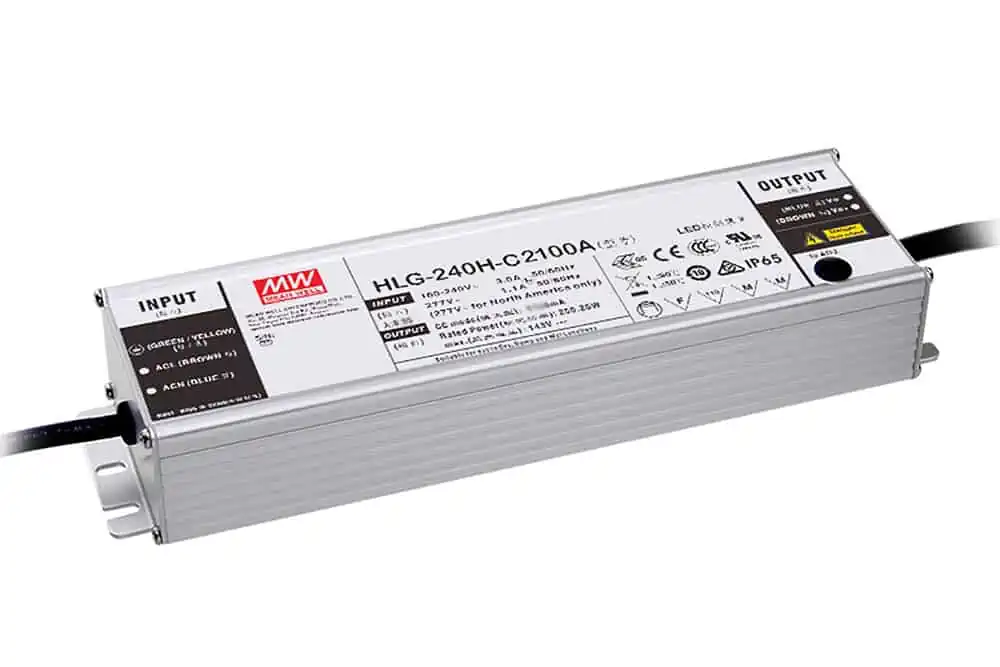
What Is A Ballast And Why Are They Not Used In LED Lights?
When light bulbs were made for the first time, they had a mechanism inside them. The job of this thing was to slow down the flow of electricity through a circuit. Ballast is the name of this thing. If this wasn’t used in light bulbs and T8 light bulbs, there was still a chance that too much electricity could build up (tube lights). Ballast is still used in bulbs and tube lights to keep the current from getting too high. Ballasts are also often used with HID, metal halide, and mercury vapor lights.
- Magnetic Ballast
Inductors, also called magnetic ballasts, give some lamps the right electrical conditions to start and run. Act as a transformer, giving out clean and accurate electricity. Even though it was made in the 1960s, it was used from the 1970s to the 1990s. You can find them in High-Intensity Discharge (HID) lamps, Metal Halide lamps, mercury vapor lamps, fluorescent lamps, neon lamps, and so on. Before LEDs started to replace this technology around 2010, it was used in almost all important parking lots and street lights for about 30 years.
- Electric Ballast
In an electric ballast, a circuit is used to limit the load or amount of current. Electronic ballast tries to keep the flow of electricity more steady and accurate than magnetic ones. People started using these more in the 1990s, and they are still used today.
- Function Of A Ballast
A ballast controls how much electricity goes to the bulbs and gives them enough power to turn on. Since lamps don’t have control, they can use too much or too little electricity on their own. The ballast ensures that the amount of electricity going into the lamp doesn’t exceed what the light’s specifications allow. Without a ballast, a light or bulb will quickly draw more and more electricity, which could get out of hand.
When a ballast is put into a lamp, the power is stable, and the ballast controls the energy so that the current doesn’t go up even when the lights are connected to high-power sources.
- Why Don’t LEDs Use A Ballast?
LEDs don’t need a ballast for several reasons. First of all, LED lights don’t use much electricity. Also, you need an AC-to-DC converter since LEDs usually run on Direct Current (DC). The socket must be wired directly when switching to LED corn light bulbs. Lastly, because LEDs are much smaller than bulbs and tube lights, there is no extra space for ballast to fit. LED drivers can be made to take up much less space. Some experts also think that because LEDs don’t need a ballast, they use less energy and give off more light.
- Ballasts vs. LED Driver
LED and fluorescent lights can’t work without a converter between the bulb and the power source. On one hand, standard incandescent lamps heat a filament with electricity to make light. LEDs, on the other hand, use led drivers instead of ballasts. Ballasts and lead drivers do many of the same things, so getting them mixed up is easy.
This is made possible by fluorescent ballasts, which send out a high-voltage spike at the start of the lamp’s life. Once the light is turned on, this spike acts as a current regulator. The led power driver changes the power source into a specific voltage and current, which then makes the LED light up. Both of them keep the light from being affected by the power source.
An LED driver is needed to change the alternating current into the direct current that LEDs need. LEDs can’t be powered directly by alternating current, so an LED driver is required to change it. Ballasts have changed a lot in how they are made and how complicated they are. Ballasts can run fluorescent lights but not LEDs or lights that use less energy. Several LED drivers seemed to have taken out the ballasts. Because it works better, the LED driver can do most of the things that the ballast does.
How To Use An LED Driver?
Instructions for setting up LED drivers
- Make sure your LED driver works with both the LED systems you want to connect it to and the power source you want to use. Both the Amperage and Voltage ratings must be the same.
- Make sure the driver won’t have to deal with problems in the environment that it wasn’t made to handle. For example, if you want to put LEDs outside, ensure the driver can handle water well enough.
- Once you know which wires are positive and negative, you can unplug your socket from the grid.
- Use screws of the correct color to attach the driver to the LED system.
- Connect the positive and negative wires from the LED system to the right terminals on the driver.
- Connect a grounding terminal to the green grounding wire coming from the driver (the GND).
- Connect the positive and negative wires from the power socket to the positive and negative terminals on the driver.
- Check the installation carefully to ensure that all the connections are tight and in the right place and that heat is not building up. If something goes wrong, turn off the power and figure out what’s wrong.
How To Repair An LED Light Driver?
- Turn the power off.
- Open the driver with a screwdriver and look carefully for burn scars and other flaws that are easy to see.
- Use electrical testing equipment to find the parts that are broken.
- If you can, switch out these parts and test the device again. If it can’t be done, the whole driver has to be changed.
Factors To Consider Before Choosing An LED Driver
- DC Dimming
Would you like LEDs to be less bright? Or do you plan to change how bright it is? Then choose a dimmable driver or power supply. Why? The power sources are easy to tell apart because of how they work. The specifications table also has extra information, like what kinds of dimmer controls can be used with the drivers.
- Power Requirements
One of the first things to consider is how much voltage your lamp needs. So, if your LED needs 20 volts to work, you should buy a 20-volt driver.
In short, the goal is to ensure that your driver gets the right amount of power. The general rule is that you should do your job within the range of the light.
For a constant-voltage driver, you can also think about the voltage range. But you can measure both voltage and current ranges with a constant-current driver.
Pay attention to how much voltage the proposed LED light will use. So, ensure the LED driver can handle the voltage from the LED. In this way, it is easy to step down to the needed output voltage.
Also, you should think about watts. During this process, make sure to buy a driver with a higher maximum wattage than the light.
- Power Factor
The power factor helps determine how much power the driver uses from the electrical network. And the range is usually from -1 to 1. Since this is the case, a power factor of 0.9 or more is the norm. In other words, as the number gets closer to one, the driver works better.
- Safety
Your LED drivers should meet several different standards. For example, we have UL classes 1 and 2. Use the UL Class 1 for drivers that put out a lot of voltage. The fixture needs to be set up safely for drivers in this group. It can also hold more LEDs, which makes it work more efficiently.
At the level of LEDs, the UL Class 2 drivers don’t need a lot of safety features. It also meets the standards set by UL1310. Even though this class is safer, it can only run a certain number of LEDs at a time.
The IP rating is another way to measure how safe a driver’s cage is and what it can do. If you see IP67, for example, it means that the driver is safe from dust and brief immersion in water.
- Efficiency
This part is crucial because it shows how much power the LED driver needs. The value is shown in terms of percentages. So, you could expect it to work between 80% and 85% of the time.
Benefits Of An LED Driver
Low voltages of 12 to 24 volts power LEDs with direct current. So, even if your AC voltage is high, between 120 and 277 volts, an LED driver will change the direction of the current. In other words, stepping down from alternating to direct current is helpful. You can even find the right amount of high and low voltage.
LED drivers keep LEDs safe from changes in voltage or current. If the voltage of an LED changes, the current supply may change. Because of this, LED lights’ output is inversely related to how many they have. LEDs are also only supposed to work within a specific range. So, too little or too much current will change how much light comes out or cause the LED to break quickly because it gets too hot.
Overall, LED drivers have two main benefits:
- Changing from AC to DC.
- The drivers help ensure that a circuit’s current or the voltage doesn’t drop below its rated level.
Does New Illuminant Equal New Dimming?
Other light sources can be turned off quickly by changing the voltage, but LEDs can only be turned off by changing the ratio of voltage to current. Because of this, there are different ways to dim LEDs:
- With pulse width modulation (PWM) or pulse duration modulation (PDM), the amount of time that voltage is given can be changed (PDM). However, the voltage itself does not change. In other words, PWM quickly turns the LEDs on and off. This happens a lot when the frequency is above 100 Hz. The brain thinks the room is darker because the human eye can’t tell flickering is happening until at least 75 Hz.
- Triacs and phase control dimmers were first made for 60W incandescent bulbs, which give off a low amount of light when the phase angle is 130°. On the other hand, LEDs are much better and use much less electricity to light up. Because of this, LEDs are not very dim at a phase angle of 130°. Also, the holding current may not be enough to keep the triac in the conductive state when the dimming is high. Because of this, LEDs start to flicker. Still, some LED drivers are built on the inside to get around this problem.
- 1-10V: In the 1-10V method, ballasts and control units are connected by a polarized two-wire control line. DC voltages between 1 and 10 volts are used to control the light, and as the voltage increases, so does the light’s brightness. You can dim LED elements with 1-10V, but they need power sources. The control unit must also be able to take in the current that the power supply sends through the control line. So, 1-10V dimming is a better choice for large lighting systems.
When Does An LED Driver Become Necessary?
Most of the time, every LED light source needs a driver. But the main question should be, “Do I have to buy one separately?” The problem is that some LED light bulbs have a driver built right in. Also, LEDs made for home use often come with LED drivers. And a great example is 120-volt bulbs with bases that are either GU24/GU10 or E26/E27.
Low-voltage LEDs, such as tape lights, MR bulbs, outdoor-rated lights, panels, and other lighting fixtures, need an LED driver to work correctly.
When working with low-voltage LEDs, you need LED drivers. But you can’t say the same about 120-volt LED bulbs used in homes.
Print Mounting And HighBay Mounting
LEDs can be put in HighBay mounting and print mounting in several ways, depending on the project’s needs: For example, so-called SMD (surface-mounted device) LEDs can be used in tighter spaces. Because they can be soldered onto printed circuit boards, they don’t need wires. Still, check to make sure that all of the parts fit together.
In bigger rooms, there needs to be more light. Because of this, factory halls and department stores use HighBay spotlights, which are powerful ceiling lights. These have to be wired separately, but they are very strong. They can be wired to the standard mains voltage of 230V AC. To keep the LEDs from getting too hot, drivers like the XBG-160-A are connected in front of them. These have protection against overload that can actively limit how much current is sent.
LED Driver Types
- Constant-Current
This LED driver only needs a fixed amount of output current and a range of output voltages. Constant current is a specific output current measured in milliamps or amps and has a range of voltages that change depending on how much the LED is being used (its wattage or load).
- Constant-Voltage
Constant-voltage LED drivers have a constant output voltage and a maximum output current. The LED module also has a regulated current system that a simple resistor or an internal constant-current driver can power.
They only need a single steady voltage, usually 12 or 24 volts DC.
- LED Drivers For AC
Theoretically, this LED driver could run halogen or incandescent lights with low voltage. But standard transformers can’t be used with AC LED drivers because they can’t tell when the voltage is low. So, they have transformers that don’t have a minimum load.
- Dimmable LED Drivers
With these LED drivers, you can dim your LED lights. It also lets you control the brightness of LEDs with a constant voltage. And it does this by reducing the amount of current that goes to the LED light before it turns on.
Applications Of LED Drivers
- Automotive LED Drivers
With high-quality automotive LED drivers, you can tell the difference between your car’s inside and outside lighting systems in many ways:
- The group of headlights
- infotainment
- Interior and rear lighting
- Backlight LED Drivers
LCD backlight LED drivers often use a specific dimming scheme to control the backlight’s brightness.
- Illumination LED Drivers
You can set up your devices with LED drivers to have infrared lighting. It can also be done with the help of a multi-topology constant-current controller.
- RGB LED Drivers
With RGB LED drivers, you can add an animation or an indicator to your LED arrays with more than one color. Also, they often work with many standard interfaces.
- Driver for LED displays
With the help of LED display drivers, you can control which LED strings use the least and most power. So, these drivers can be used with either a large narrow pixel or a matrix solution for small or mini LED digital signage applications.
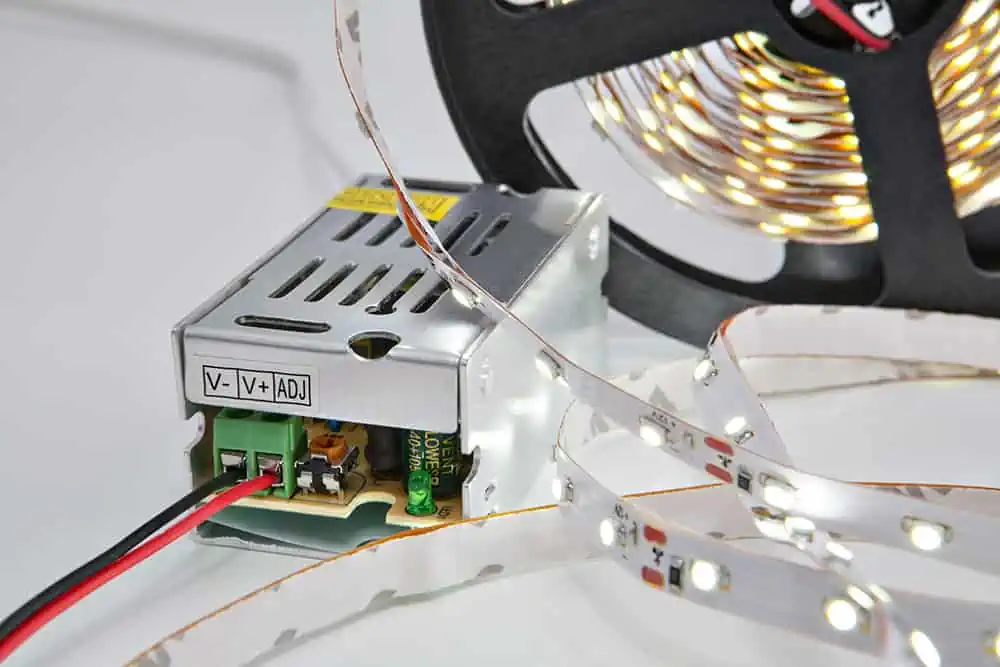
What LED Driver Do I Need?
To figure out what size LED driver will meet your needs, you need to know the following:
- The voltage of the mains power that you’ll be using
- The total amount of power that the system’s LEDs use
- What kind of voltage or constant current do the LEDs need
If there are any other technical factors, like the need for precise color control or the possibility of water exposure, that can affect how the LED drivers work. The LED’s IP rating shows how resistant it is to water; a higher rating means it is more resistant. With an IP rating of 44, the product can be used in kitchens and other places where water might occasionally splash on it. A driver with a high IP rating, like 67, can be used outside. Drivers with an IP rating of 20 should only be used inside, where it’s dry.
More information, you can read How To Choose the Right LED Power Supply.
FAQs
LEDs are made to work with low voltages of direct current electricity (12–24V). Alternating current energy, on the other hand, is usually available and has a higher voltage (120-277V).
When 12v tape is used with a 24v driver, the LEDs will shine brighter at first, but the higher voltage will wear out the tape over time.
Use a voltmeter to check the LED driver’s output voltage.
Depending on the type and color of the LED, a certain number of volts are often needed. Most experts say that LEDs should be run on 2-3 volts.
Most LEDs can’t be powered when the 3.3V source can deliver more current than the LED can safely handle. To determine how much resistance an LED has, you need to know two things about it. It is safe if the current from the 3.3V source is less than the maximum amount the LED can handle.
If you give more than 12V DC to a 12V LED strip, you risk overdriving it and damaging the circuit and onboard components by burning out the diodes or causing too much heat to build up.
Use an LED driver with the same minimum value as your LED (s). The driver’s output power must be higher than what the LEDs need for extra safety. If the output is the same as how much power the LED needs, it is running at full capacity. Running at full power could make the driver’s life-span short.
If you need to control each LED in a pixel strip separately, you may want to use a 5V system. If not, a 12V pixel strip with 3 LEDs per pixel may be more than enough.
For LED lights to work, they need a specific voltage, like 24V or 12V. When they work at higher voltages, they get very hot. When the heat is very high, it hurts the LED lights or the soldering around them. Damage from heat makes LED lights dim, flicker, or even go out.
The wattage of a driver tells you how much power it can put out at its highest level. To ensure the LED tape lasts longer, it’s best to use a driver that can handle at least 10% more wattage than the tape needs.
LEDs perform better at 24V.
Think about how you are using an LED strip that is 8.5 m long. Every LED strip meter uses 14W. 14 times 8.5 equals 119 Watts. So, you need an LED power supply, also called an LED driver, that can put out at least 119 Watts.
A driver can power as many LED lights as it can handle. The only thing that can stop them is the total wattage of the LED lights they power.
The colors of the cables are red, black, and white. Red is the first positive, and black is the second positive. The white light becomes the ground.
Any LED strip light needs either 12v or 24v to work.
Yes, you can
Drivers often fail before they should because their working temperatures are too high. Electrolytic capacitors, which look like batteries, often kill the device. Electrolytic capacitors have a gel inside that slowly evaporates over the life of the driver.
Due to too much voltage, LED drivers and distribution panels break down faster than they should.
The life of an LED can be anywhere from 10,000 to over 50,000 hours, depending on how well the heat sink works, how the capacitor is built, and the overall quality.
Connecting more than one LED to a constant current LED driver in parallel is not a good idea.
For an LED to work, its positive (anode) terminal must be connected to the positive (+ve) supply, and its negative (cathode) terminal must be connected to the negative (-ve) supply. LEDs can only be electrically polarized when their positive and negative terminals are connected. When connecting an LED, you must be very careful about the polarity.
There are two of them on each one. The first switch turns on the 40-watt filament. The second switch turns it off and turns on the 60-watt filament. The last switch turns on both filaments, giving a total output of 100 watts.
Summary
LED drivers are used in many different industries, just like LEDs. You can also light your space with the wide range of transformers, power supplies, and drivers available. Because LEDs are so flexible, adding smart features and changing the brightness is easy. In this way, LED drivers are essential to making modern, practical, and cost-effective lighting.
LEDYi manufactures high-quality LED strips and LED neon flex. All of our products go through high-tech laboratories to ensure the utmost quality. Besides, we offer customizable options on our LED strips and neon flex. So, for premium LED strip and LED neon flex, contact LEDYi ASAP!
